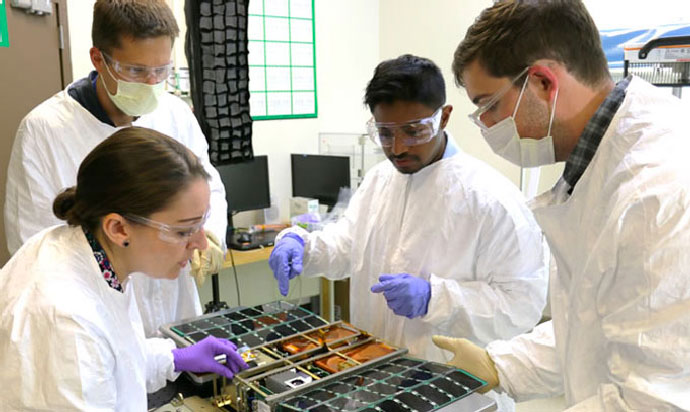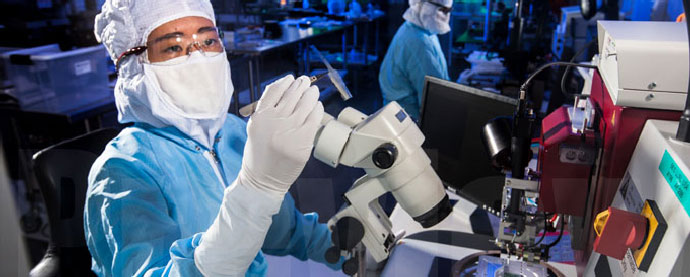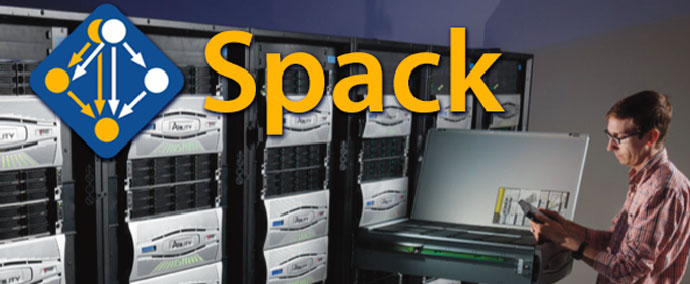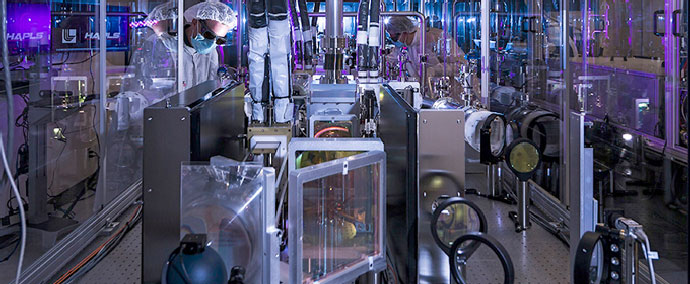Expanding the boundaries of scientific knowledge and advancing the technological state of the art to solve problems of national and global importance
From the atom to the universe, Livermore studies natural phenomena at wide-ranging scales and develops technologies that enhance safety and security, preserve health, and improve quality of life. Science and technology research and development provide the tools for carrying out that mission.
Nanosatellites Ready to Fly
To demonstrate a new paradigm in the architecture of space systems, LLNL researchers have been developing innovative instruments, an adaptable platform, and operational principles for a type of nanosatellite called the CubeSat. Drawing on Livermore’s expertise in precision optics, researchers designed a high-resolution monolithic optical telescope as small as 8.5 centimeters in diameter. In early 2018, the innovative, lightweight telescope, fabricated from a single piece of fused silica, was launched into low-Earth orbit as a demonstration system. The telescope produced excellent imagery of both stellar fields and ground targets. Potential CubeSat applications being considered for the low-cost imaging system include commercial and government Earth observations, space debris detection and tracking, and astronomical science observations. In addition, using a fleet of smaller satellites for a mission spreads the risk and provides “resiliency.”
The Laboratory’s latest CubeSat, called MiniCarb, is a collaboration between LLNL and NASA’s Goddard Space Flight Center. MiniCarb uses the LLNL-developed CubeSat next-generation bus designed to standardize requirements and allow easier interchangeability of components. It will house an instrument for measuring the concentration of greenhouse gases in the Earth’s atmosphere at specific altitudes of interest. MiniCarb is expected to be launched in 2019.
Plumbing Mysteries of the Brain
With its 100 billion neurons and 100 trillion interconnections, the brain presents a formidable challenge to scientific efforts aimed at understanding how it works and developing treatments for neural conditions. Laboratory scientists, working with the University of California at San Francisco and other partners, are using a flexible LLNL-developed neural probe containing a biocompatible microelectrode array to record brain activity in animals and humans over long durations. The hope is that lengthy recordings of brain activity will lead to better diagnosis and treatment for neurological disorders like Parkinson’s disease, and neuropsychiatric conditions including depression and post-traumatic stress disorder. Research teams are using the probes in various ways, recording electrical signals from single neurons and regions of the brain, and adapting the probes to measure the chemical signaling of neurotransmitters in the brain.
Game-Changing Concussion Study
A group of more than 40 researchers including LLNL scientists have identified evidence of early chronic traumatic encephalopathy (CTE) brain pathology after head impact even when signs of concussion were not present. The findings help explain why approximately 20 percent of athletes with CTE never suffered a diagnosed concussion. The study included the analysis of human brains from teenagers with recent head injury, animal experiments that re-created sports-related head impact and military-related blast exposure, and computational models of skull and brain injuries as they occur. The supercomputing simulations performed by Livermore researchers played a significant role in confirming that traumatic head motions from either blast or impact lead to CTE. Concussion is a separate phenomenon that results from shear stress when pressure is loaded through a focused point, as is often the case for impacts. Early indicators of CTE pathology not only persist long after injury but also spread through the brain, providing the best evidence to date that repeated head impact, not concussion, causes CTE.
Leadership in Scientific Computing
Researchers at Livermore continued to push the frontiers of computing power and speed. LLNL is fully engaged (including staff as members of the management team) in DOE’s Exascale Computing Project, a collaboration between NNSA and the DOE Office of Science to develop and deliver exascale computers critical to national security, discovery, and economic competitiveness. In addition to research efforts for NNSA, Livermore participants are part of six teams awarded time on supercomputers at Argonne and Oak Ridge national laboratories as part of the Office of Science’s Innovative and Novel Computational Impact on Theory and Experiment (INCITE) program. Livermore personnel were also prominent contributors to DOE’s attention-grabbing news, displays, and presentations at the SC17 and SC18 supercomputing conferences.
LLNL is also advancing the application of high-performance computing through broad partnerships—notably in the area of bioscience and biotechnology. Livermore, the Frederick National Laboratory for Cancer Research, GlaxoSmithKline, and the University of California at San Francisco have joined forces in the ATOM (Accelerating Therapeutics for Opportunities in Medicine) consortium—using big data and supercomputers to transform cancer drug discovery. ATOM aims to reduce the time it takes for an identified drug target to become a clinical candidate from the usual six years to one year.
In addition, the Laboratory has partnered with the American Heart Association to speed up drug development for cardiovascular diseases using data science and simulation. Livermore also launched a supercomputing effort with two other DOE national laboratories in collaboration with the Transforming Research and Clinical Knowledge in Traumatic Brain Injury (TRACK-TBI) consortium to better understand TBI.
A Software Manager for Supercomputers
Spack (short for Supercomputer PACKage manager) is an LLNL-developed open-source package manager optimized for high-performance computing (HPC). It has become one of the most popular pieces of software LLNL has ever released to the GitHub open-source community. The tool automates installation and fine-tuning of simulations and libraries. Efficient packaging tools are critical in HPC environments because supercomputer simulations rely on hundreds of external software libraries. Spack is the go-to package manager for DOE laboratories’ supercomputers and has become the official deployment tool for the Exascale Computing Project.Advanced Manufacturing Breakthroughs
Livermore-developed new advanced materials and manufacturing processes supported LLNL’s national security missions and served to strengthen the economy and help create jobs. Along with its research partners, the Laboratory 3D printed a common form of marine-grade stainless steel, which is widely used in corrosive and high-stress environments such as aerospace, automobiles, chemical processing, and medical implants. The 3D-printed steel’s strength and ductility were demonstrably superior to the traditional manufactured material. In addition, a Laboratory research team reported a breakthrough in 3D-printed complex graphene aerogels, which are lighter than air and stronger than steel. The process will be able to produce microarchitected structures with a complexity beyond anything produced so far. Graphene aerogel applications include advanced batteries, supercapacitors, and other energy technologies; water desalination; and chemicals processing. Livermore also advanced the 3D printing of nanoporous gold, which could revolutionize the design of electrochemical reactors to process clean fuels or convert carbon dioxide into useful products.
Developing new processes for advanced manufacturing is a continuing Laboratory focus. A research team demonstrated the use of machine learning to prevent defects in real time in 3D-printed metal parts. Another team discovered ways of improving the capabilities of a nanoscale 3D-printing method called two-photon lithography, which can print features one-hundredth the width of a human hair. Researchers also demonstrated how to use hologram-like 3D images to significantly accelerate “volumetric” printing of complex 3D parts, and how x-ray imaging can improve the quality of 3D printing.
Quantum Computing’s Revolutionary Potential
Quantum computing could be the next step in the evolution of faster, more powerful supercomputers. Laboratory researchers, working in a full-capability quantum computing laboratory and test bed facility, have built a prototype quantum computing device to explore the technology and determine how these machines might markedly advance DOE and NNSA missions. The team is also developing algorithms for solving quantum simulation problems on the prototype, which is a cylindrical metal box with a sapphire chip suspended within. The box is kept inside a refrigerated vacuum tube to preserve its superconductive state. Rather than digital ones and zeroes, these systems use the quantum states of atoms chilled to nearly absolute zero to carry out calculations. Quantum computers have the potential to solve some complex problems far more rapidly than traditional digital systems.
Other Planets Big and Small
Scientists have long theorized that water becomes superionic when heated to several thousand degrees at high pressure, similar to the conditions inside giant planets such as Uranus and Neptune. In superionic ice, liquid-like hydrogen ions move within a solid lattice of oxygen. Livermore and partners have published the first experimental evidence for superionic conduction in water ice at planetary interior conditions, verifying a 30-year-old prediction. Using shock compression, the team found predicted thermodynamic signatures including a high melting point, near 5,000 kelvin at 2 million atmospheres of pressure. Superionic ice may help explain the magnetic fields of Uranus and Neptune.
Livermore researchers’ interests range widely in the science of nearby and exoplanets. Using computer simulations, they found that the bands of Jupiter, zonal flows of gas, are primarily a surface phenomenon—its strong magnetic fields suppress band formation deeper within the planet. Meanwhile, Livermore cosmochemists have been studying Martian meteorites, fragments of rock from Mars knocked into space through collisions and recovered on Earth. Measurements of xenon gas trapped in these fragments reveal the evolution of the Martian climate and suggest little atmospheric change in 4 billion years, and that liquid water has not been abundant on its surface since the planet’s first few hundred million years.
Discovering Properties of Materials
By coupling high-performance computer simulations with laboratory experiments, LLNL researchers are finding answers to some enduring mysteries of materials. Their results could lead to better materials for a variety of technologies. One team studied the process of how radiation causes defects in silicon, the basis of modern electronics, discovering that damage done to a material strongly depends on the density of cascades of radioactive particles colliding with it. The team’s goal is to better understand the physical process to develop improved methods of protecting materials from radiation damage.
How the boundaries of grains that form a material affect its mechanical and chemical properties is a longstanding puzzle. Most materials are not uniform solids, but are made of tiny grains marked by boundaries consisting of various structures. Interested in how metals perform under extreme conditions, Livermore scientists have used powerful molecular dynamics simulations to study grain boundaries and discover, for example, why blacksmiths’ methods for metal hardening work so well. LLNL researchers have developed a first-of-its kind tool that uses machine learning to sample the billions of possible boundary structures, find low-energy arrangements of atoms, and learn about their dynamic properties. The new tool for modeling grain boundaries has been successfully tested on selected materials. It will enable improved design of many energy technologies such as fuel cells and thermoelectrics, sensors, and laser optics.
Expanding Industrial Partnerships
LLNL is benefiting the U.S. economy with innovative technology and methods. In FY 2018, LLNL filed 144 new patents (including 43 provisional patents), obtained 105 new copyrights, and licensed 50 new technologies. Licensing income for the year totaled approximately $5.1 million. DOE’s Technology Commercialization Fund is giving a valuable boost to Livermore’s innovations. In 2018, LLNL researchers captured three large-scale cooperative development grants ($650,000 to $750,000), which directly connect Laboratory researchers with industrial partners, and two technology maturation grants (less than $150,000). The cooperative development grants include one to advance the Earth Battery, a technology for storing renewable energy from intermittent sources until it is needed; a pioneering application for LLNL’s microencapsulated sorbent to remove carbon dioxide from air (see Energy and Environment); and a project to speed qualification of additively manufactured parts. The technology maturation grants include a fiber amplifier that could improve the stability of the nation’s electrical grid and a method for rapidly manufacturing nanocrystal devices.










